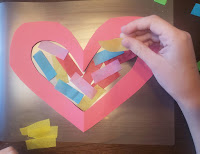Valentine's Day is one of my favorite holidays for crafting! I love the colors and all the hearts. Here are a few simple Valentine's crafts my kids and I tried this year:
Upcycled Heart Stamp Art
For this craft you will need:
-several toilet paper rolls
-several paper or plastic plates
-white paper
-washable paints
Start by covering your work space, this activity can be a little messy. Then choose a few paint colors to use. We used red, pink, and purple since they seemed like good Valentine's Day colors. Pour some paint onto the plates, one color per plate.
Fold the toilet paper rolls so that they are shaped like hearts.
Have your kids dip the ends of the toilet paper rolls in paint and use the them to stamp hearts onto the white paper.
Fingerprint Heart Tree
For this craft you will need:
-white paper
-a brown marker
-watercolors or tempra paints
Start by helping your kids draw a tree trunk with some branches growing off it, then color it in with the brown marker. Or grab a free printable heart tree template here: Printable Valentine's Day Heart Tree Template
Have your kids add heart shaped flowers to their tree by making fingerprints with the paints. Make one finger print then turn your finger about 90 degrees and make another so that they overlap at the bottom, making them look like a heart.
Heart Suncatchers
For this craft you will need:
-Construction paper
-Tissue paper squares
-Contact paper
-Scissors
Start by cutting a large heart out of a piece of construction paper, then cut a smaller heart out of the center of the large heart.
Cut two pieces of contact paper large enough to stick your paper heart to. Then peel one and stick your construction paper heart to the sticky side.
Stick tissue paper pieces to the contact paper inside of the construction paper heart, making a thin layer of tissue paper.
Peel the second piece of contact paper and carefully stick it, sticky side down, over the piece with the heart and tissue paper.
Cut around your heart, leaving a small trim of contact paper around the construction paper heart.
Now your suncatcher is ready to be hung in a sunny window. You can either tape it to the window, or punch a hole in the top and string a piece of yarn through to make a handle to hang it from.
If you enjoyed this craft, check out these other fun Valentine's crafts:
-Upcycled Heart Suncatcher Craft
Follow me on:











Comments
Post a Comment